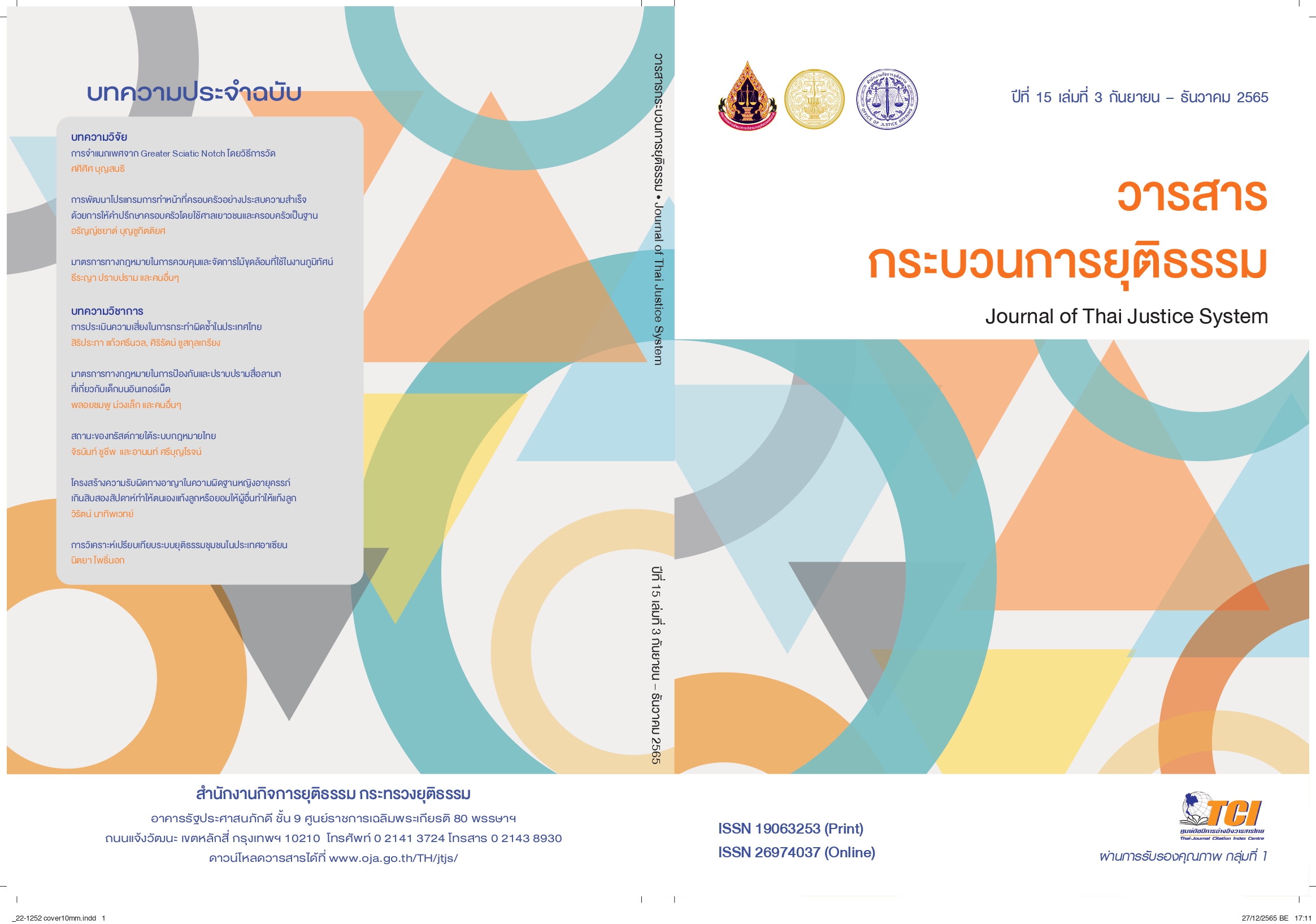Criminal liability structure for a woman over twelve weeks of pregnancy causing her own miscarriage or allowing someone else to cause an abortion
Main Article Content
Abstract
This paper aims to explain the criminal liability of a woman with over twelve weeks of pregnancy causing a miscarriage of herself or allowing other persons to cause an abortion under the Section 301of the Criminal Code as an explanation tool. Firstly, it was found that Section 301 of the Criminal Code only applies to women with over 12 weeks of pregnancy. The law does not specify whether a woman with a pregnancy up to 12 weeks of gestation is required to be under the care and consultation of a qualified medical practitioner. Moreover, from the information of the Department of Health, Bureau of Reproductive Health in 2019, the live birth ratio of children between the ages of 10 to 14 was found to be 1.1 per 1,000 whereas the live birth ratio of women aged 15-19 years was 31.3 per 1,000. Consequently, since the self-abortion without the supervision and consultation of the medical practitioner is allowed by the law, termination of pregnancy of an underage child could endanger the child or encourage them to opt for illegal clinic service. Secondly, the Section 305 of the Criminal Code has described the offence exemption for pregnant women with over 12 weeks of pregnancy and medical practitioners, including those performed under the supervision of a medical practitioner. This is subjected to the Medical Council Regulation on Criteria for Termination of a Medical Pregnancy of a Medical Practitioner under Section 305 of the Criminal Code B.E. 2021. In accordance with Article 5 of the Medical Council of Thailand regulations, the termination of pregnancy for women in conditions related to physical or mental disorders that are unable to make their own decisions, the consent of lawful representative or caregiver is required. Based on the regulations of the Medical Council, in case legal representatives or caregivers are not able to give a consent without sensible reason or any conflict of interest is concerned, the pregnancy termination will be legitimately depending on the women’s decision. In addition, the pregnancy termination must be done if there is a mental or physical health risk to the pregnant women in line with the conditions for legal termination of pregnancy under the Criminal Code, Section 305 (1). Besides, according to the Criminal Code, Section 305 (2), pregnancy termination has to be done if there are substantial risks or convincing medical reasons of serious deformities and disabilities to the newborn baby. Therefore, the law should specifically allow legal practitioners to make a decision only in urgent case related to women's health or serious harm. In case of non-urgent condition or non-fatal required pregnancy termination in line with the Criminal Code, Section 305 (2), legal measures by the court as a decision-making mediator must be implemented. Consequently, the judgment of the court can be intentionally expressed the most benefit to the pregnant women as well as the legal resolutions of pregnant women for any argument involving with their physical or mental disorders to the non-consensual pregnancy termination by the medical practitioner.
Article Details

This work is licensed under a Creative Commons Attribution-NonCommercial-NoDerivatives 4.0 International License.
Published Manuscripts are the copyright of the Journal of the Justice System. However; the opinions that appeared in the content are the sole responsibility of the author.
References
กรกฎ ทองขะโชค. (2560). กฎหมายอาญา บทบัญญัติทั่วไป (พิมพ์ครั้งที่ 2). สงขลา: นำศิลป์โฆษณา.
กรมอนามัย, สำนักอนามัยการเจริญพันธุ์. (2562). รายงานเฝ้าระวังการแท้งประเทศไทย พ.ศ. 2562. ค้นเมื่อ 21 ธันวาคม 2565, จาก https://rh.anamai.moph.go.th/webupload/migrated/files/rh/n330_da80b22d8a4daa876f459095915af6d_Ebook_Abortion_62.pdf
กระทรวงสาธารณสุข, กรมสุขภาพจิต, สำนักบริหารระบบบริการสุขภาพจิต. (2560). คู่มือการดูแลผู้ป่วยโรคจิตเภทสำหรับโรงพยาบาลในเขตสุขภาพ (ฉบับแพทย์) (พิมพ์ครั้งที่ 2). นนทบุรี: ผู้แต่ง.
เกรียงไกร เจริญธนาวัฒน์. (2561). หลักพื้นฐานกฎหมายมหาชน (พิมพ์ครั้งที่ 4). กรุงเทพฯ: สำนักพิมพ์วิญญูชน.
เกียรติขจร วัจนะสวัสดิ์. (2562). คำอธิบายกฎหมายอาญา ภาค 1 เล่ม 1 (พิมพ์ครั้งที่ 11). กรุงเทพฯ: กรุงสยาม พับลิชชิ่ง.
ไกรฤกษ์ เกษมสันต์. (2559). คำอธิบายประมวลกฎหมายอาญา ภาคความผิด มาตรา 288-มาตรา 366 (พิมพ์ครั้งที่ 10). กรุงเทพฯ: สำนักอบรมศึกษากฎหมายแห่งเนติบัณฑิตยสภา.
คณพล จันทน์หอม. (2563). หลักพื้นฐานกฎหมายอาญา เล่ม 1. กรุงเทพฯ: สำนักพิมพ์วิญญูชน.
คณพล จันทน์หอม. (2564). คำอธิบายกฎหมายอาญาภาคความผิด เล่ม 2 (พิมพ์ครั้งที่ 6). กรุงเทพฯ: สำนักพิมพ์วิญญูชน.
คณิต ณ นคร. (2545). กฎหมายอาญาภาคความผิด (พิมพ์ครั้งที่ 8). กรุงเทพฯ: สำนักพิมพ์วิญญูชน.
คณิต ณ นคร. (2563). กฎหมายอาญาภาคทั่วไป (พิมพ์ครั้งที่ 7). กรุงเทพฯ: สำนักพิมพ์วิญญูชน.
จรัญ โฆษณานันท์. (2559). สิทธิมนุษยชนไร้พรมแดน : ปรัชญา กฎหมาย และความเป็นจริงทางสังคม (พิมพ์ครั้งที่ 3). กรุงเทพฯ: สำนักพิมพ์นิติธรรม.
จิตติ ติงศภัทิย์. (2555). กฎหมายอาญา ภาค 1 (พิมพ์ครั้งที่ 11). กรุงเทพฯ: เนติบัณฑิตยสภา.
ต่อพงศ์ กิตติยานุพงศ์. (2562). ทฤษฎีสิทธิขั้นพื้นฐาน (พิมพ์ครั้งที่ 2). กรุงเทพฯ: สำนักพิมพ์วิญญูชน.
ทวีเกียรติ มีนะกนิษฐ และรณกรณ์ บุญมี. (2564ก). กฎหมายอาญา ภาคทั่วไป (พิมพ์ครั้งที่ 22). กรุงเทพฯ: สำนักพิมพ์วิญญูชน.
ทวีเกียรติ มีนะกนิษฐ และรณกรณ์ บุญมี. (2564ข). คำอธิบายกฎหมายอาญา ภาคความผิดและลหุโทษ (พิมพ์ครั้งที่ 18). กรุงเทพฯ : สำนักพิมพ์วิญญูชน.
นิมิต ชิณเครือ. (2559). กฎหมายแพ่ง (พิมพ์ครั้งที่2). กรุงเทพฯ: สำนักพิมพ์รามคำแหง.
ปกป้อง ศรีสนิท. (2559). กฎหมายอาญาชั้นสูง. กรุงเทพฯ: สำนักพิมพ์วิญญูชน.
ปกป้อง ศรีสนิท. (2563). สิทธิมนุษชนในกระบวนการยุติธรรมทางอาญา (พิมพ์ครั้งที่1). กรุงเทพฯ: สำนักพิมพ์ วิญญูชน.
ปฏิพล สันธนาคร. (2554). การศึกษาเปรียบเทียบประสิทธิผลของยาไมโสพรอสตอล ขนาด 400 และ 600 ไมโครกรัมเหน็บทางช่องคลอดในการยุติการตั้งครรภ์ที่อายุครรภ์น้อยกว่า 20 สัปดาห์ ในโรงพยาบาลศรีสะเกษ. วารสารการแพทย์ โรงพยาบาลศรีสะเกษ สุรินทร์ บุรีรัมย์, 26(2), 230-131.
ผู้จัดการออนไลน์. (2564). สภารับหลักการร่างแก้ไข ป.อาญาฯ เด็กอายุต่ำกว่า 12 ปี ไม่ต้องรับโทษ. ค้นเมื่อ 22 มีนาคม 2565, จาก https://mgronline.com/politics/detail/9640000091493
รัชดาภรณ์ ใจอ้าย. (ม.ป.ป.). เอกสารประกอบการสอนรายวิชา 619252 การพยาบาลสุขภาพจิตและจิตเวช 2 เรื่องการพยาบาลผู้ที่มีปัญหาทางจิตเวชด้านความคิดและการรับรู้. ค้นเมื่อ 23 ธันวาคม 2564, จาก
http://sutir.sut.ac.th:8080/sutir/bitstream/123456789/4894/1/42.pdf
รุ่งศรี แสงแก้วศรี. (2552). ประสิทธิภาพการจัดการกับอาการหูแว่วของผู้ป่วยโรคจิตเภทในจังหวัดพิษณุโลก.วารสารพยาบาลศาสตร์ 3(1), 18-33.
ลักษณวัต ปาละรัตน์. (2553). ปรัชญาภาวะสตรี. กรุงเทพฯ: สำนักพิมพ์มหาวิทยาลัยรามคำแหง.
วรมน รามางกูล. (2564). แนวคิดและความเป็นมาของกฎหมายเกี่ยวกับการยุติการตั้งครรภ์ในประเทศไทย. วารสารดุลพาห, 68(1), 1-34.
วินัย ล้ำเลิศ. (2557). กฎหมายอาญา 1 (พิมพ์ครั้งที่ 4). กรุงเทพฯ: สำนักพิมพ์มหาวิทยาลัยรามคำแหง.
วิรัตน์ นาทิพเวทย์. (2564). ความรับผิดทางอาญาและกระบวนการยุติการตั้งครรภ์แทนในกรณีหญิงที่รับตั้งครรภ์แทน. วารสารกระบวนการยุติธรรม, 14(2), 37-56
วิบูลพรรณ ฐิตะดิลก และพชร ศรีปน. (2564). จากข้อบังคับแพทยสภาสู่การปฏิบัติข้อบังคับแพทยสภาว่าด้วยหลักเกณฑ์การปฏิบัติเกี่ยวกับการยุติการตั้งครรภ์ทางการแพทย์ฉบับใหม่ตามมาตรา 305 แห่งประมวลกฎหมายอาญา 2564. ค้นเมื่อ 21 ธันวาคม 2564, จาก https://tmc.or.th/Media/media-2021-08-20-10-53-06.pdf
วิสูตร ฟองศิริไพบูลย์. (2551). แพทย์ยุติการตั้งครรภ์ (ทำแท้ง) ให้กับหญิงภายใต้เงื่อนไขที่แพทยสภากำหนด: กฎเกณฑ์ทันยุคที่แพทย์ไทยทุกคนต้องรู้. วารสารเวชบันทึกศิริราช, 1(2), 114-123.
วิณัฏฐา แสงสุข และฐิติพร ลิ้มแหลมทอง. (2557). ความรู้เบื้องต้นเกี่ยวกับกฎหมายทั่วไป (พิมพ์ครั้งที่4). กรุงเทพฯ: สำนักพิมพ์มหาวิทยาลัยรามคำแหง.
ศาลฎีกา. (ม.ป.ป.). ระบบสืบค้นคำพิพากษา คำสั่งคำร้องและคำวินิจฉัยศาลฎีกา. ค้นเมื่อ 28 ธันวาคม 2564, จาก http://deka.supremecourt.or.th/search
สุภัชลี เทพหัสดิน ณ อยุธยา. (2556). โครงสร้างความรับผิดอาญา : ศึกษากระบวนการคิดของกฎหมายอาญาเยอรมันเพื่อปรับใช้กับกฎหมายอาญาไทย. วารสารธรรมศาสตร์, 32(3), 40-73.
สรวุฒิ เกษมสุข และวรรณวิภา เมืองถ้ำ. (2562). ความผิดปกติทางจิตในกฎหมายอาญา : ศึกษาเฉพาะคำศัพท์ นิยาม และการตีความทางกฎหมาย. วารสารกฎหมายสุขภาพและสาธารณสุข, 5(1), 41-55.
หยุด แสงอุทัย. (2556). กฎหมายอาญา ภาค 2-3 (พิมพ์ครั้งที่ 11). กรุงเทพฯ: สำนักพิมพ์มหาวิทยาลัยธรรมศาสตร์.
หยุด แสงอุทัย. (2561). คำอธิบายกฎหมายลักษณะอาญา ร.ศ. 127 (พิมพ์ครั้งที่ 7). กรุงเทพฯ: สำนักพิมพ์วิญญูชน.


